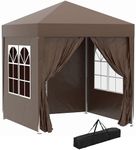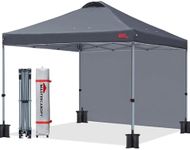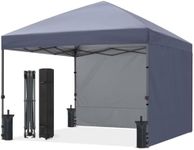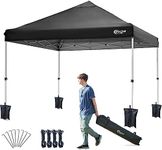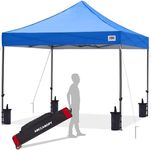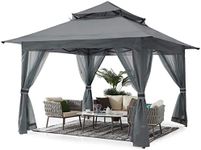Buying Guide for the Best Pop Up Canopies
Pop-up canopies are versatile and convenient shelters that can be used for a variety of outdoor activities, such as camping, picnics, parties, and market stalls. When choosing a pop-up canopy, it's important to consider several key specifications to ensure you select the best fit for your needs. Understanding these specifications will help you make an informed decision and get the most out of your purchase.SizeThe size of a pop-up canopy is crucial because it determines how much space you will have under the shelter. Sizes typically range from small (6x6 feet) to large (12x12 feet or more). Smaller canopies are easier to transport and set up, making them ideal for personal use or small gatherings. Larger canopies provide more coverage and are better suited for bigger events or commercial use. Consider the number of people and the amount of equipment or furniture you need to accommodate when choosing the size.
MaterialThe material of the canopy fabric and frame affects durability, weather resistance, and overall performance. Canopy tops are usually made from polyester or polyethylene, with varying degrees of water resistance and UV protection. Frames are typically constructed from steel or aluminum. Steel frames are heavier and more durable, making them suitable for frequent use and windy conditions. Aluminum frames are lighter and more portable but may not be as sturdy. Choose a material based on how often you plan to use the canopy and the typical weather conditions in your area.
Ease of SetupEase of setup is an important factor, especially if you plan to use the canopy frequently or need to set it up quickly. Pop-up canopies are designed to be easy to assemble, but some models are more user-friendly than others. Look for features like one-piece frames, push-button sliders, and clear instructions. If you often set up the canopy alone, consider a model that is specifically designed for solo assembly. Reading user reviews can also provide insights into how easy a canopy is to set up.
WeightThe weight of a pop-up canopy affects its portability and stability. Lighter canopies are easier to transport and set up, making them ideal for casual use or events where you need to move the canopy frequently. Heavier canopies, on the other hand, offer better stability and are less likely to be affected by wind. If you plan to use the canopy in windy conditions or leave it set up for extended periods, a heavier model may be more suitable. Consider how you will transport the canopy and the typical conditions where you will use it.
Weather ResistanceWeather resistance is a key factor in ensuring your canopy can withstand various outdoor conditions. Look for canopies with water-resistant or waterproof fabric to protect against rain, and UV protection to shield from the sun's harmful rays. Some canopies also feature wind vents or reinforced corners for added stability in windy conditions. Assess the typical weather in your area and choose a canopy with the appropriate level of weather resistance to ensure it meets your needs.
Additional FeaturesAdditional features can enhance the functionality and convenience of your pop-up canopy. These may include sidewalls for added privacy and protection, adjustable height settings, carrying bags for easy transport, and anchor systems like stakes or sandbags for added stability. Consider which features are important for your intended use. For example, sidewalls can be useful for market stalls or events where you need extra protection from the elements, while adjustable height settings can provide flexibility for different setups.
